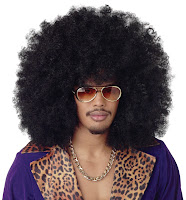DEFINITION: The
afro comb is exactly what it sounds like: a device invented to comb and maintain natural black hair. Today's combs are very different from the afro combs of Africa:
The Afro-Comb is modeled in a way that is best suited for African American hair. The wide spaces between the teeth of the comb allow thicker hair to pass through them.
ROOTS: The Traditional African Comb
The afro comb, or afro pik as it is referred to by many, finds its roots in Africa. The date of its' origin, however, is difficult for researches to find. Researches DO know that the African Comb was a significant part of black culture.
Combs served a great purpose to Africans. They were not only tools--a means to make the monotonous daily activities a little more simple--but they too were gifts, pieces of art, and beautifully crafted artifacts that told tales of its owner's people.
Combs were mainly crafted from wood, hand-carved by men that often spent days, even weeks perfecting their art. Combs were also carved out of other materials like ceramics, fish or animal bones, and even ivory, when accessible.
Left: a comb carved out of Ivory, most likely originating from the Ivory Cost
Right: an ornate comb carved from pewter and ceramic.
Traditional wedding comb
Combs were often given to women as a gifts by an adoring male. A Bridal comb, like the one above, was often given to a woman on the day of her marriage. These combs were especially large, ornate and intricately carved. They decorated the brides home, and were used on extremely special occasions. The more combs a woman had, the more wealth or beauty a visitor could assume she possessed.
The importance of proverbs, and oral history to African tribes manifested itself in their art. Combs were often designed with a specific story or proverb in mind.
The comb to the left displays the image of two birds with their backs to one another. This image conjures up the Ghanian proverb that attests to a chiefs omniscience. The proverb states, "The chief sees everything, even what is behind him."

















